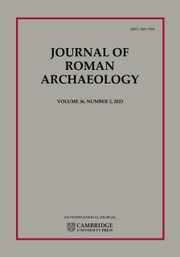Dear Colleagues and Friends,
In 2020, John Humphrey retired after 33 years as the editor of the Journal of Roman Archaeology. At the end of volume 33, he describes JRA's founding and growth, his vision for the journal, and his decision now to entrust the journal to Cambridge University Press. (The JRA Supplement series has remained with him and is not part of the move to Cambridge.) The present issue of JRA is the first one published by Cambridge University Press and the new editorial team; a second issue will follow in December.
Readers will note a great deal of continuity. JRA publishes long articles and shorter notes, review articles as well as book reviews. Articles and notes go through a double-blind peer-review process; criteria include relevance, originality, depth of research, and methodological rigor. The material cannot have been published previously – even in another language – and the discussion should appeal to a professional readership beyond a specific site, region, or topic. JRA book reviews are substantial interventions, often offering a broader contextualization or a discussion of the larger issues at stake. All the book reviews in the present issue were commissioned by Humphrey, as will be some portion of those in the December issue.
John Humphrey envisioned JRA as an international journal, and this will not change. Roman archaeology's evidence base spans several continents, and its scholarly community stretches even more widely. In the past year, submissions have come in from 26 different countries. Accordingly, the journal will continue to publish in English, French, German, Italian, and Spanish. The present issue covers sites and materials ranging from the city of Rome to Spain in the west, Algeria and Egypt in the south, Gaul and Germany in the north, and Turkey, Israel, and – a first for JRA – Georgia in the east. In addition, Humphrey recognized the strong connections between Roman history and archaeology, connections that readers will see in this issue as well.
At the same time, this transition has involved a new editorial team, a new publisher, and new processes, and readers will therefore notice some changes. Starting in 2021, JRA will publish two issues per year, in June and December, each containing both articles and reviews. All articles and reviews are published on the journal's website (https://www.cambridge.org/core/journals/journal-of-roman-archaeology/firstview) as soon as they go through production, as well as appearing in the journal's print and digital issues. Every article includes an abstract and keywords; citations are by author and date in the footnotes, with a bibliography at the end. A new feature for JRA is the online Supplementary Material; this is always free to access and will be ideal for the publication of long tables, extra images, catalogs, and other data that provide necessary support for the published article but cannot be accommodated in the journal's pages. Information about JRA's new policies, as well as instructions for authors, can be found online at https://www.cambridge.org/core/journals/journal-of-roman-archaeology/information.
A difficult challenge continues to be the COVID-19 pandemic, which has disrupted archaeological fieldwork and closed research libraries, among its many other effects. Certain articles in this issue have been affected (as is noted in their acknowledgments) and we expect to see the impact of the pandemic for some time to come. A perhaps related challenge concerns gender balance. Only 35% of the articles submitted to JRA in the past year were authored or co-authored by women, a proportion that does not represent the actual population of students and professionals in Roman archaeology. We hope to improve these numbers over time, and to continue publishing a wide range of authors in terms of career stage and institutional location, as well as other axes of diversity.
For the future, JRA's top priority remains unchanged: to attract, publish, and review the best current scholarship in Roman archaeology. What this means, of course, changes over time. As cutting-edge methods, approaches, and debates within the field evolve, JRA evolves as well. We aim to publish a broad geographical, theoretical, and scientific range of work. Archaeological best practices include ethical considerations, and JRA is expressly following two ethical policies: the AIA Policy on the Presentation and Publication of Undocumented Antiquities, and the UNESCO Convention on the Protection of the Underwater Cultural Heritage and its Annex Rules. With JRA's move to a major publisher like Cambridge University Press, there are also new possibilities that will enhance the dissemination of scholarship published in the journal, either through the increased list of institutional subscribers (including many that will receive free access through organizations such as Research4Life) or via Open Access options that are now available to authors.
The present issue marks a transition from JRA's extraordinary first 33 years into an exciting future. In this transitional period, a new Editorial Board, together with an Advisory Board made up of both continuing and new members, are providing welcome expertise and help. We thank our authors as well, not only for their excellent scholarly work but also for their good grace and collaborative spirit through these changes. Above all, none of this would be possible without the founding editor's tremendous achievement. We therefore dedicate this inaugural issue of the “new” JRA to John Humphrey.
https://www.cambridge.org/core/journals/journal-of-roman-archaeology

